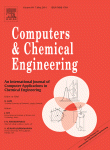 Authors: Luís DOMINGUES¹, Carla I.C. PINHEIRO¹, Nuno M.C. OLIVEIRA²
Authors: Luís DOMINGUES¹, Carla I.C. PINHEIRO¹, Nuno M.C. OLIVEIRA²
Affiliations: ¹IBB -Institute for Biotechnology and Bioengineering, Instituto Superior Técnico, Universidade de Lisboa, Av. Rovisco Pais 1, 1049-001 Lisboa, Portugal and ²CIEPQPF, Department of Chemical Engineering, Universidade de Coimbra, Rua Sílvio Lima – Pólo II, 3030-790 Coimbra, Portugal
Reference: Domingues, L., Pinheiro, C. I. C., & Oliveira, N. M. C. (2014). Optimal design of reactive distillation systems: Application to the production of ethyl tert-butyl ether (ETBE). Computers and Chemical Engineering, 64, 81–94.
Abstract: “This work addresses the design of reactive distillation columns to produce ETBE, based on a detailed first-principles model that considers equilibrium and kinetic information, rigorous physical property data, and catalyst deactivation. An evolutionary algorithm is used to generate a sequence of feasible designs with improved characteristics in a sequential solution/optimisation strategy, by specifying the design variables (both integer and continuous) that characterise a particular column configuration. Two classes of optimisation algorithms are compared: genetic algorithms and particle swarm optimisation. The objective function considered is the gross annual profit…”
DOI: 10.1016/j.compchemeng.2014.01.014
Comments: as mentioned in the abstract, the authors rely on a detailed first-principles model. This model has been developed in gPROMS ModelBuilder 3.5.1 and the rigorous physical property data “calculated by Aspen Plus 2006.5, interfaced via the CAPE-OPEN standard”. So this work relies on the CAPE-OPEN Thermodynamic socket available in gPROMS and on the CAPE-OPEN Thermo System known as Aspen Properties. This constitutes an additional example of seamless interoperability between gPROMS and Aspen Properties.
